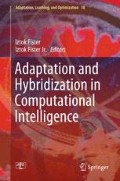Abstract
Tuning parameters of artificial neural networks (ANN) is a very complex task that typically demands a lot of experimental work performed by developers. In order to avoid this hard work, the automatic tuning of these parameters is proposed. A real-coded genetic algorithm (GA) was developed for this purpose. This, so-called meta-GA, algorithm acts as a meta-heuristic that searches for the optimal values of ANN parameters using the genetic operators of crossover and mutation and evaluates quality of solutions, obtained after applying the ANN for fire analysis of steel frames. As matter of fact, steel exhibits very unusual wavy behavior which is a very difficult to model by a close form empirical models when heated to the temperatures between 250°C and 600°C. Therefore, the use of ANN was one of the possible solutions which proved to be very promising. However, the results of this ANN with manual parameter setting by an expert can significantly be improved when using the meta-GA for automatic searching the optimal parameter setting of the original ANN algorithm.
Access this chapter
Tax calculation will be finalised at checkout
Purchases are for personal use only
Preview
Unable to display preview. Download preview PDF.
References
Kirby, B.R., Preston, R.R.: High temperature properties of hot-rolled, structural steels for use in fire engineering design studies. Fire Safety Journal 13, 27–37 (1988)
Eurocode 3: Design of steel structures, Part 1.2: General rules-Structural fire design. European Committee for Standardisation, Brussels (2001)
British Standard Institute. BS5950-8:Structural Use of Steelwork in Building - Part 8: Code of Practice for Fire Resistance Design. British Standards Institution, London (2003)
Lippmann, R.P.: An Introduction to Computing with Neural Nets. IEEE Magazine on Acoustics, Signal and Speech Processing 4(2), 4–22 (1987)
Sarle, W.S.: Neural Network FAQ. Periodic posting to the Usnet newsgroup comp.ai.neural-nets (2002), ftp://ftp.sas.com/pub/neural/FAQ.html
Huang, Z.F., Tan, K.H.: Effects of External Bending Moments and Heating Schemes on the Responses of Thermally-restrained Steel Columns. Engineering Structures 26(6), 769–780 (2004)
Seed, G.M., Murphy, G.S.: The applicability of neural networks in modelling the growth of short fatigue cracks. Fatigue & Fracture of Engineering Materials & Structures 21, 183–190 (1998)
Haque, M.E., Sudhakar, K.V.: ANN based prediction model for fatigue crack growth in DP steel. Fatigue & Fracture of Engineering Materials & Structures 23, 63–68 (2001)
Sterjovski, Z., Nolan, D., Carpenter, K.R., Dunne, D.P., Norrish, J.: Artificial neural networks for modeling the mechanical properties of steels in various applications. Journal of Materials Processing Technology 170, 536–544 (2005)
Sakla, S.S.S.: Neural network modeling of the load-carrying capacity of eccentrically-loaded single-angle struts. Journal of Constructional Steel Research 60, 965–987 (2004)
Oreta, A., Kawashima, K.: Neural Network Modeling of Confined Compressive Strength and Strain of Circular Concrete Columns. Journal of Structural Engineering 129(4), 554–561 (2003)
Tang, C.W., Chen, H.J., Yen, T.: Modeling Confinement Efficiency of Reinforced Concrete Columns with Rectilinear Transverse Steel Using Artificial Neural Networks. Journal of Structural Engineering 129(6), 775–783 (2003)
Zhao, Z.: Steel columns under fire - a neural network based strength model. Advances in Engineering Software 37(2), 97–105 (2004)
Mikami, I., Tanaka, S., Hiwatashi, T.: Neural Network System for Reasoning Residual Axial Forces of High-Strength Bolts in Steel Bridges. Computer-Aided Civil and Infrastructure Engineering 13, 237–246 (1998)
Papadrakakis, M., Lagaros, N.D., Plevris, V.: Design optimization of steel structures considering uncertainties. Engineering Structures 27, 1408–1418 (2005)
Hozjan, T., Turk, G., Srpčič, S.: Fire analysis of steel frames with the use of artificial neural networks. Journal of Constructional Steel Research 63, 1396–1403 (2007)
Michalewicz, Z.: Genetic algorithms + data structures = evolution programs. Springer, Berlin (1992)
Goldberg, D.E.: Genetic Algorithms in Search, Optimization and Machine Learning. Addison-Wesley Longman Publishing Co., Inc., Boston (1989)
Deb, K.: Multi-Objective Optimization Using Evolutionary Algorithms. John Wiley & Sons, Inc.,, New York (2001)
Goldberg, D.E., Deb, K.: A comparative analysis of selection schemes used in genetic algorithms. In: Foundations of Genetic Algorithms 1 (FOGA-1), pp. 41–49 (1991)
Eshelman, L.J., Schaffer, J.D.: Real-coded genetic algorithms and interval-schemata. In: Foundations of Genetic Algorithms 2 (FOGA-2), pp. 187–202 (1993)
Deb, K., Agrawal, R.B.: Simulated binary crossover for continuous search space. Complex Systems 9(2), 115–148 (1995)
Deb, K., Kumar, A.: Real-coded genetic algorithms with simulated binary crossover: Studies on multi-modal and multi-objective problems. Complex Systems 9(6), 431–454 (1995)
Eiben, A., Smith, J.: Introduction to Evolutionary Computing. Springer, Berlin (2003)
Fister, I., Mernik, M., Filipič, B.: Graph 3-coloring with a hybrid self-adaptive evolutionary algorithm. Computational Optimization and Applications 54(3), 741–770 (2013)
Fister, I., Mernik, M., Filipič, B.: A hybrid self-adaptive evolutionary algorithm for marker optimization in the clothing industry. Applied Soft Computing 10(2), 409–422 (2010)
Fister Jr, I., Yang, X.-S., Fister, I., Brest, J., Fister, D.: A brief review of nature-inspired algorithms for optimization. Electrotechnical Review 80(3), 116–122 (2013)
Fister Jr, I., Suganthan, P.N., Strnad, D., Brest, J., Fister, I.: Artificial neural networks regression on ensemble strategies in differential evolution. In: 20th International Conference on Soft Computing, Mendel 2014, pp. 65–70. University of Technology, Faculty of Mechanical Engineering, Institute of Automation and Computer Science, Brno (2014)
Author information
Authors and Affiliations
Corresponding author
Editor information
Editors and Affiliations
Rights and permissions
Copyright information
© 2015 Springer International Publishing Switzerland
About this chapter
Cite this chapter
Hozjan, T., Turk, G., Fister, I. (2015). Hybrid Artificial Neural Network for Fire Analysis of Steel Frames. In: Fister, I., Fister Jr., I. (eds) Adaptation and Hybridization in Computational Intelligence. Adaptation, Learning, and Optimization, vol 18. Springer, Cham. https://doi.org/10.1007/978-3-319-14400-9_7
Download citation
DOI: https://doi.org/10.1007/978-3-319-14400-9_7
Publisher Name: Springer, Cham
Print ISBN: 978-3-319-14399-6
Online ISBN: 978-3-319-14400-9
eBook Packages: EngineeringEngineering (R0)

